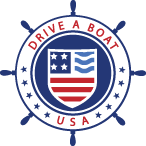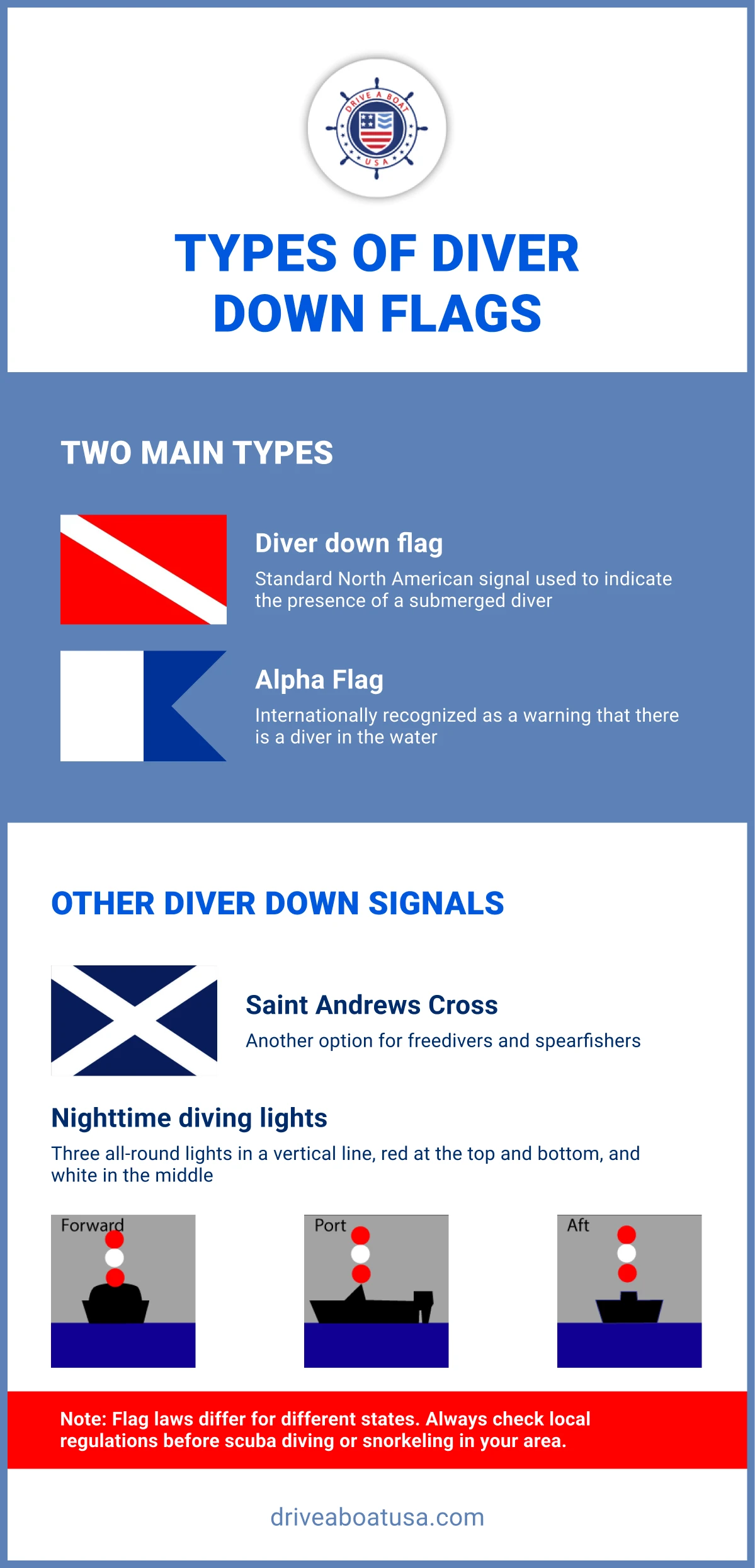Diver Down Flag: What It Looks Like and When To Use It
Federal law stipulates that scuba divers and snorkelers in the United States use a specific type of flag to warn boaters of their presence in the water.
Purpose of a diver-down flag
Diver down flags are an important type of safety equipment that can prevent collisions between boats and divers and minimize the risk of propellor strikes. Diver flags can save lives!
A diving flag alerts boaters and PWC operators to the fact that there are people who are partly submerged or completely underwater in a given area. Boaters must either:
- Avoid the area completely
- Exercise caution and go slowly when in the vicinity.
Two main types of diving flags
All diving flags serve the same overall purpose. There are two flag types:
 1. Divers Flag
1. Divers Flag
This rectangular red flag has a white diagonal stripe from the upper left corner to the lower right corner. It is a standard signal used to indicate the presence of a submerged diver in the area to boaters in North America and some other parts of the world.
Boater responsibility: Boats are required to stay at least 300 feet away from the flag in open water, and 100 feet away in inlets or navigation channels. By law, this flag must be displayed when diving activities are taking place.
Diver responsibility: Divers are typically required to stay within 150 feet of the flag when underwater.
2. Alpha Flag
This blue-and-white International Code Flag A (or Alfa flag) is a pennant flag (rectangular with a pointed end), with a triangular shape.
It is internationally recognized as a warning that there is a diver in the water, however some states stipulate that the red and white flag must be used at the same time or instead of the Alpha flag.
To get a definitive answer about which underwater activities require a flag in your area, consult local maritime regulations or contact the relevant authorities, such as the Coast Guard or local marine safety.
Boater responsibility: In many areas, displaying this flag is mandatory when a vessel is involved in diving operations. It indicates that the vessel flying the flag has reduced maneuverability due to diving activities. It also signals to other boats that there is a diver in the water, instructing them to maintain a safe distance and reduce speed when approaching.
Diver responsibility: Divers should stay within a reasonable distance of the flag. While not specifically mentioned for the Alpha flag, the general guideline for diver-down flags is to stay within 90 meters (300 feet) in open water.
Where not to use a diving flag
Divers should not place the flag in an area already occupied by other boaters or where their diving operations will impede the normal flow of waterway traffic.
Other types of diving flags
The St. Andrew’s Cross diving flag is sometimes used to signal the presence of freedivers or spearfishers. This flag has a blue background and a white X. When freediving, you may need to adapt how you use the flag. For instance, you might:
- Have a buddy hold the flag at the surface
- Use a longer line (though this comes with other risks)
- Use a weighted buoy that stays at the surface while you dive
Diving at night
Night-time diving involves following different rules, since flags aren’t visible in the dark. International regulations stipulate that vessels engaged in diving activities at night must display three all-round lights in a vertical line where they can be seen best:
- The highest and lowest lights must be red.
- The middle light must be white.
These lights indicate to other boats that there are divers in the area, and the vessel has limited manoeuvrability.
It’s important to note that these light signals are in addition to any other required navigation lights for the vessel. Always check local regulations as well.
When to use a diver-down flag
Diving flags should only be used when a person is currently partly submerged or actively engaged in underwater activities, including snorkeling, diving, freediving, underwater photography or videography, underwater surveys or scientific research, or underwater construction or maintenance.
Where to display your diver-down flag
Diver-down flags should be displayed where they are clearly visible to other water users.
- On a vessel: Choose a highly visible location, ideally at the highest point, on a pole. According to international regulations, the Alpha flag should be a rigid replica at least 1 meter (39 inches) in height, displayed prominently near the highest point of the vessel for optimal visibility. For diver down flags, the minimum size is typically 20 x 24 inches when displayed on a boat.
- On a float or buoy: Diver down flags may also be displayed on a float or buoy. Make sure the flag is high enough that it will be visible even if waters are choppy, and choose a buoy that is stable and unlikely to topple. The minimum size is usually 12 x 12 inches or 15 x 15 inches, depending on local regulations, when displayed on a buoy or float.
Diver and boater responsibilities during diving activities
Boat operators are responsible for everyone on board their boat, including those who are diving from it. They should be able to recognize diver down flags and know how to respond accordingly. Never steer your vessel between a flag and the shoreline, and keep an eye out for bubbles that could indicate a diver is surfacing.
Anchor your boat before diving, make sure you are using a dependable vessel, and always respect the boat capacity plate to avoid capsizing.
Divers can also drift away from the flag, so be careful at all times when boating anywhere near a diving flag, and always respect the rules of right-of-way.
Divers should always use a diver-down flag and stay close to avoid accidents. Never dive or snorkel alone.
Remember, it’s possible to fall into the water unexpectedly, especially when enjoying towed watersports like tubing or water skiing. If this happens, you will not have a diver down flag handy. Instead, you’ll need to rely on hand signals to alert boaters to your presence in the water.
Get your boating licence and learn about diver safety from Drive A Boat USA
Be safe and have fun! Get your state-specific NASBLA and U.S. Coast Guard approved boating license today, so you can be confident and prepared to enjoy boating and diving activities anywhere in the United States.


 1. Divers Flag
1. Divers Flag